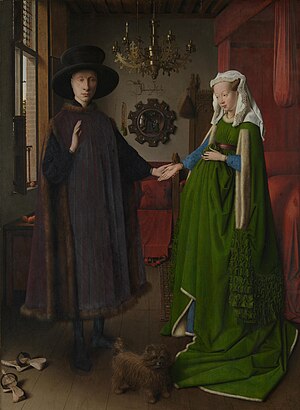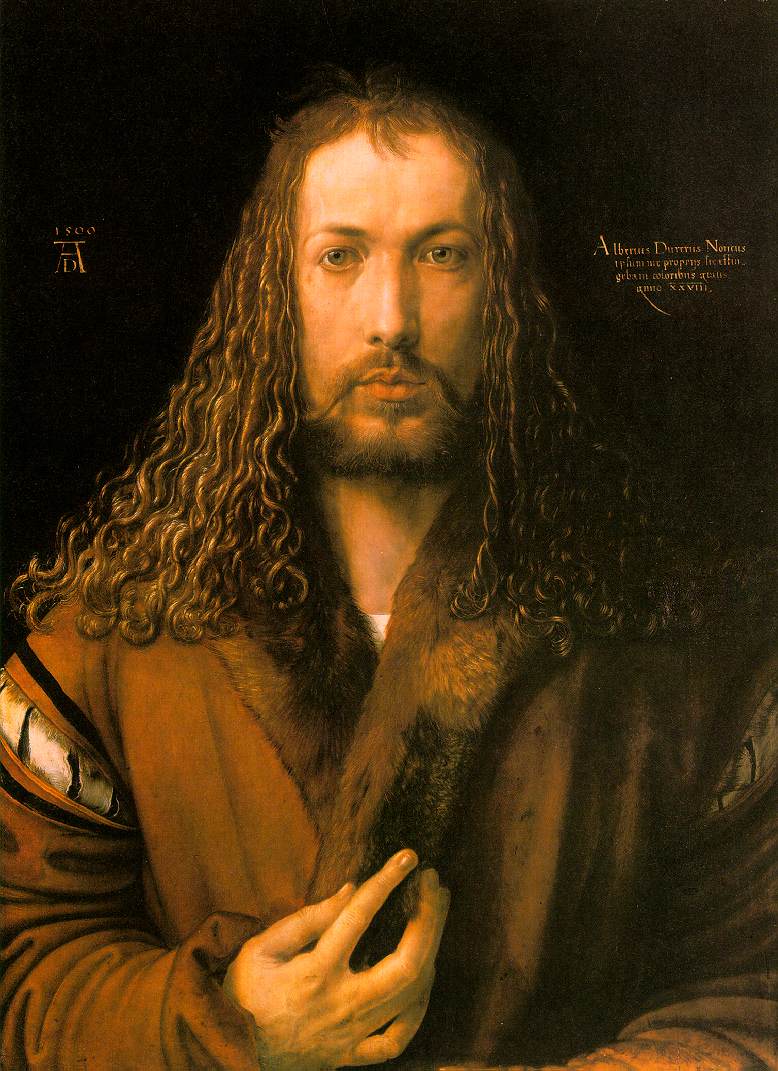This quarter learning about the art of the renaissance and the small periods after wards, I was particularly drawn to one specific period the entire time. The period of the early northern renaissance and the paintings and sculptures that came out of that period have astonished and inspired me as a visual artist. Had we not have looked at some of the van Eyck paintings, I do not know if I would have connected to this class as much as I have. As a lighting designer for theatre, it was truly amazing to start off the quarter with paintings that almost directly deal with how light reflects off of the image. The slow and tedious process of adding small thin layers one after the other to create a large assortments of different sheens and textures is what astonishes me the most. Jan van Eyck’s’ Arnolfini is a perfect example of this.
Examining the painting we see a varied assortment of textures that all reflect light a different way. The lace looks like real lace, the hair on the dog looks like real hair. The fabric is a different texture in one area then the under fabric. And then you have the mirror in the background with its highly reflective surface. It looks nice and glossy and van Eyck even went as far as to even give us a sense of perspective as the image in the mirror is curved just like any domed shaped mirror would be. Also what I enjoy is the pure naturalism of the human forms. No one here is trying to make these people beautiful or idealized. No, instead they are real to life humans that you could meet on the street. The way van Eyck used light to create the texture and his use of small thin layers to create a rich depth is a technique that I have learned to adore and enjoy seeing in later pieces.
Now my favorite piece of this entire class, while not early northern renaissance, is Albrecht Durër’s Self-portrait. I think it is fair to tie this painting to the early northern renaissance because it captures the same use of thin layers and the reflectivity of light to create a variety of realistic textures. In his face we see an awesome level of detail almost to the point were you can tell this man has pores. As well the hair is a create topic of discussion. The three types of hair present in this; his head hair, beard, and coat hair, all have a different feeling to them. They all look different but support the naturalism of the painting. But where the real fun coms from for me is within the eyes. They seem moist, and they glisten from a light sourc coming from the upper left corner. This choice is followed through in every other part of the image. He has picked a light source and everything is shadowed and highlighted based on that.
The attention to how light works in painting is what I believe allowed the northern renaissance the ability to create very naturalistic paintings. And that is why that period and those paintings were my favorite to examine over this past quarter


I love starting this course with Jan van Eyck, for some of the reasons that you mentioned. I feel like no one can look at van Eyck's work without being at least somewhat impressed (to say the very least!). I'm glad that he captured your attention just as we started this course.
ReplyDelete-Prof. Bowen
I loved reading your post! I also love Durer's "Self Portrait". It is amazing how he chose the lighting to be so perfect so it highlights some parts of the body, and shadows the less important parts. I like how you brought up the different kinds of hair in this painting. Great post!
ReplyDeleteAh! Van Eyck is also a serious favorite of mine. I love the amount of detail he put into the paintings and how he 'signed' his work with his own image.
ReplyDeleteJan van Eyck use of light is also amazing because he incorporated the natural direction of light from the real world, and included that light in his painting as if it was actually affecting the subjects in the paintings. His painting of the Altar of Ghent shows the light source coming from the right side of the painting where there was a real window where the painting was supposed to be installed. That is very impressive to me.
ReplyDeleteThe Arnolfini Portrait is definitely one of my favorites as well, even though I did not write about it in my own blog. I love all the detail in this piece. We can get a real snap shot of these people's lives and get some of their personality. What I also find so interesting about van Eyck's painting that it is a portrait, but also tells a story.
ReplyDelete